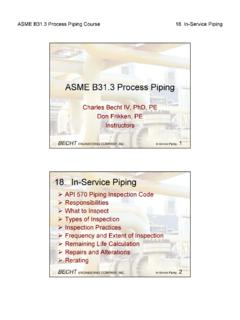Transcription of Roller Wave Distortion – Definition, Causes and a …
1 glass Processing Days, 18 21 June 12226 Roller Wave Distortion definition , Causes and a Novel Approach to Accurate,On-line MeasurementHigh-quality, low- Distortion , heat-treated glasscan be consistently manufactured using on-linemeasurement of roll Main textA new technology has been developed tomeasure roll wave Distortion on-line as glassconveys out of a tempering furnace. The newsystem measures every lite exiting the furnacewhile the glass moves at normal conveyor system mounts over existing conveyors. Rolldistortion is displayed to operators as peak-to-valley measurements. The measurements arestored in a quality control database for later reviewand analysis.
2 These systems are being installedtoday and are rapidly changing the qualityparadigm for heat-treated the demand for heat-treated productsgrows, a complementary trend is toward morestringent flatness requirements. Architects andend users frequently demand products free ofvisual Distortion . Laminated products require aprescribed flatness for manufacturing. 3 mm and4 mm glass is often desired but not available forthese markets due to difficulty in controllingdistortion. New applications are requesting 3mmand 4mm glass to be heat-treated and market dynamics offer both opportunityand challenge. Thin, flat product applications aregenerally early in their life cycle.
3 They typicallybring higher margins. The challenge is to producethinner, heat-treated glass with low Distortion onexisting furnaces. This new on-line roll wavedistortion measurement technology empowers thefabricator to meet and exceed the new Abbott & John MadocksApplied Process Technologies, = Roll distortion2 = Visual Inspection system3 = Heat treatment4 = On-line inspectionAbstractRoller wave Distortion in heat-treated glassresults in customer complaints and lost Distortion is defined in peak-to-valleymeasurement terms and related to opticaldistortion as seen by the customer. A techniqueis described to accurately measure roll distortionusing on-line optical methods.
4 Feedback tofurnace operators has resulted in dramaticimprovements in product market for heat-treated glass is North America, the demand for heat-treatedproducts grew 5% in 2000. New applications forheat strengthened and tempered glass offergrowth opportunities for glass fabricators. Post-temperable low-E coatings allow fabricators torespond rapidly to customer is growing for laminated glassapplications requiring heat-strengthened lites forone or more elements. Hurricane glass is one ofthe fastest growing products in North glazing demand is rising in Europe andAsia, and the demand for security glass is of heat-treated glass require Distortion -free products, particularly for insulatedand laminated windows.
5 The US, ASTM C 1048is undergoing revision to quantify roll-wavedistortion in heat-treated glass . UK industrystandards are moving in a similar direction. As theglass industry pursues advanced applications,quality requirements rise. Historically, the demandfor improved quality has driven industry towardimprovements in performance. Improved qualitybenefits our customers and ultimately Processing Days, 18 21 June 12 What Is Roll Distortion ?Roll Distortion is the periodic wave imparted toglass during heat-treatment. It is measured by theindustry in peak-to-valley distance. The customerperceives role Distortion as optical Distortion inreflection or transmission in the finished Distortion is the transition of flat glass into alens.
6 The severity of the lens radius defines thelens power of the curved glass and therefore theoptical Distortion in the resultant theory, heat treatment requires uniformheating of the glass to 621 +/- 3 deg C, whileholding the glass in a flat state. Heat and quenchuniformity are difficult to maintain with varyingconditions. The glass softens to a taffy-likeconsistency as it approaches the criticaltemperature. Although the furnace is designed tocontrol thermodynamic conditions, variations aredifficult to eliminate. Any roll eccentricity impartsdeformation to the glass . The leading and trailingedges of each lite form a cantilever as the glassleaves a roll.
7 The glass sags under this Causes sag between the heating and inconsistent loadingexacerbate the problems due to hot spots in thefurnace. In a perfect world, precisely enough heatis added to relieve stress without making the glasstoo soft. In reality, critical variables such as glasstype, glass thickness, coatings, furnacetemperature, atmospheric temperature, ambienthumidity and personnel constantly the trained eye of the customer, rolldistortion in heat-treated glass is observed as adistorted reflected image in the final IG installationor as a distorted transmitted image in a most expensive point to find the distortedwindow is upon installation!
8 This fun house distorted image is no fun when the glass hasreached its full value and the customer laminated products roll distortions causeFigure 1: A View of glass Sheets in Front of a Zebra Boardfabrication difficulties. Distortion in one or bothlites to be laminated leave voids which are filledwith flowing interlayer. The result is a lens affectand visible Distortion most evident in problem often discourages the use of 3mmglass for 2: Architectural example of Optical Roll Distortion inHeat-Treated IGFigure 3: Architectural example of Optical Roll Distortion inLaminated WindowThe Old Way to MeasureRoll DistortionAlthough awareness of roll Distortion hasincreased and demand for improved qualitygrows, the measurement technique for glassflatness is the same today as thirty years is still monitored on-line using a zebra board.
9 Roll Distortion is seen as waviness in thereflected image of the zebra stripes. While askilled furnace operator may effectively exposeprocess problems with the zebra board, theGlass Processing Days, 18 21 June 12228method has weaknesses. Observations aresubjective and inconsistent, measurements are notquantifiable and no permanent, traceable recordis created. Architects are specifying nodistortion in windows due the lack of quantifiablestandards. Subjective measurements inviteproblem when the product reaches the standard off-line method uses a flat-bottom GAR gauge. This tool is a flat steel bar, 300 mm(12-inches) long with a dial indicator gaugemounted in the center of the bar.
10 With this method,a sheet of glass is brought to a flat surface,preferably a granite table, and the operator dragsthe gauge over the surface of the glass whilerecording the results. The dial indicator in unitsof mm ( inches) measures rolldistortions as the gauge moves over peaks andvalleys on the glass . The disadvantages of thismethod include; The requirement for a separate, off line, step inthe process. Handling and measurement may scratch theglass in a destructive manner. The operator must be trained and human interface element is inconsistenteven with good training. An unacceptably small sample of production ismeasured.





